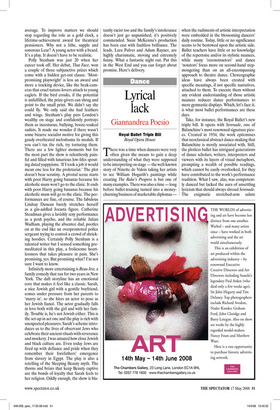Lyrical lack
Giannandrea Poesio
Royal Ballet Triple Bill Royal Opera House
There was a time when dancers were very often given the means to gain a deep understanding of what they were supposed to be interpreting on stage ŌĆö the well-known story of Ninette de Valois taking her artists to see William HogarthŌĆÖs paintings while creating The RakeŌĆÖs Progress is but one of many examples. There was also a time ŌĆö long before ballet-training turned into a money
AASpectatorhalfdoub 7/508 15:2
churning business of marketable diplomas ŌĆö when the rudiments of artistic interpretation were embedded in the blossoming dancersŌĆÖ daily routine. Today, little or no significance seems to be bestowed upon the artistic side. Ballet teachers have little or no knowledge of the repertoire and/or its stylistic nuances, while many ŌĆśreconstructorsŌĆÖ and dance ŌĆśnotatorsŌĆÖ focus more on second-hand stepmongering than on an all-encompassing approach to theatre dance. Choreographic ideas have always been created with specific meanings, if not specific narratives, attached to them. To execute them without any evident understanding of those artistic nuances reduces dance performances to mere gymnastic displays. Which, letŌĆÖs face it, is what most ballet performances are these days.
Take, for instance, the Royal BalletŌĆÖs new triple bill. It opens with Serenade, one of BalanchineŌĆÖs most renowned signature pieces. Created in 1934, the work epitomises that neoclassical abstract dance-making that Balanchine is mostly associated with. Still, the plotless ballet has intrigued generations of dance scholars, writers, interpreters and viewers with its layers of visual metaphors, prompting a wealth of possible readings, which cannot be easily overlooked, for they have contributed to the workŌĆÖs performance tradition. What I saw, alas, was competently danced but lacked the aura of unsettling lyricism that should always shroud Serenade.
Page 2
The enigmatic stretched-arm salute performed by the corps de ballet at the very beginning of the work had none of its poignant magic; likewise, the so-called ŌĆśangel of deathŌĆÖ final section, in which a male dancer crosses the stage while being blindfolded by a female dancer behind him, failed to give me ŌĆö and other Balanchine-fond friends ŌĆö the shivers it has been giving me since I first saw Serenade more than 35 years ago.
Powerful interpretation is also an essential requirement for Kim BrandstrupŌĆÖs works, whether they be narrative ones or not, as BrandstrupŌĆÖs creations always stand out because they give a vibrant dose of permeating drama. In his latest creation, Rushes ŌĆö Fragments of a Lost Story, there are many glimpses of the intense and often sombre psychological atmospheres that are so typical of his oeuvre. Still, I am not convinced that this is one of his best creations for the threesome-centred drama develops rather slowly, and is often stalled by an overabundance of choreographic images and digressions that in the end are totally superfluous. Even the cinematic solutions and quotations, hinted at in the title of the work, do not add much and often get in the way. Tamara Rojo was simply powerful as the evil-ish woman in red, and I wish her dramatic performance had been more evenly matched by that of both Leanne Benjamin and Thomas Whitehead. As the drama tries desperately to take off, amid regular but unnecessary interventions of a dancing chorus of grey-clad people, the action becomes more and more tedious, thus affecting what ought to have been a more fiery d├®nouement. Pity, for Brandstrup knows how to make good dancing and good theatre.
The composite programme concludes with the restored and reinvented Homage to the Queen: Earth, originally created by Frederick Ashton in 1953. Despite some brilliant dancing by artists of the calibre of Miyako Yoshida, Marianela Nu├▒ez, Tamara Rojo and Ricardo Cervera, the ballet remains, in my view, an over-the-top pompous folly that does no justice to its long-lost original. The starry collaboration of choreographers such as David Bintley, Michael Corder and Christopher Wheeldon ŌĆö responsible for recreating the lost parts ŌĆö does not produce the outcome one would expect and the whole thing comes across as a stylistically disjointed hotchpotch of illfitting steps and movements. Indeed, there are some ŌĆśprettyŌĆÖ moments, and many in the audience cherished the sight of traditional tutus and demanding bits of virtuoso balletdancing. Unfortunately, the rare moments of interest ŌĆö such as the final and truly Ashtonian movement ŌĆö get overwhelmed and thwarted by an exceedingly boring mass of uninteresting choreography. Placed at the end of such an unexciting programme, Homage thus has the same disheartening effect as a malfunctioning final firework. I left the theatre bored and unsatisfied, believing more and more that whoever said that ballet is a long-dead art might have a damn good point.











































































 Previous page
Previous page